Everything You Need to Know About the Temple of Heaven in Beijing
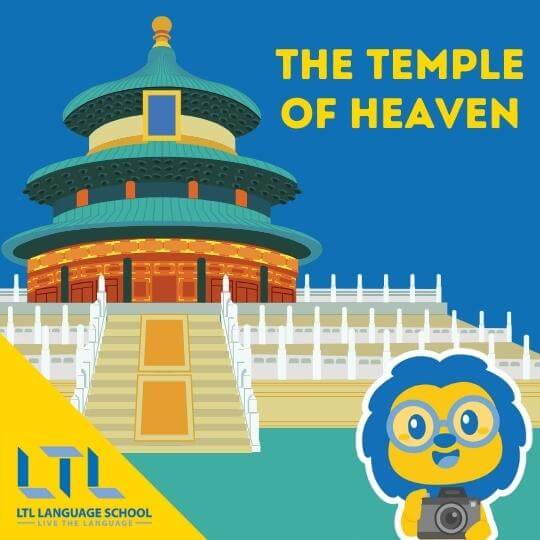
China enthusiasts, welcome to one of Beijing’s most iconic landmarks: the Temple of Heaven, in Chinese “天坛” (pinyin: tiān tán).
Nestled in the heart of Beijing’s bustling metropolis, the Temple of Heaven stands as a testament to China’s rich cultural heritage and spiritual traditions.
Let’s embark on a journey to uncover the beauty and significance of this awe-inspiring architectural wonder!
🎁 PLUS you’ll get some top tips on how to make the most of your trip to the temple of heaven!
Temple of Heaven || A Glimpse Into History
Temple of Heaven || Architectural Marvels
Temple of Heaven || Hall of Prayer for Good Harvests
Temple of Heaven || Imperial Vault of Heaven
Temple of Heaven || Circular Mound Altar
Temple of Heaven || Spiritual Significance
Temple of Heaven || Restoration Efforts
Temple of Heaven || Visiting Tips
Temple of Heaven || FAQs
Temple of Heaven || A Glimpse Into History
Our journey begins with a step back in time to the 15th century, during the reign of the Ming Dynasty.
It was Emperor Yongle (永樂) who first commissioned the construction of the Temple of Heaven (constructed from 1406 to 1420), envisioning it as a sacred space for imperial rituals and ceremonies.
Impressive, isn’t it?
Over the centuries, subsequent emperors of the Ming and Qing dynasties expanded and embellished the temple complex, transforming it into the architectural masterpiece we see today.
Fact #1: The complex was extended and renamed Temple of Heaven during the reign of the Jiajing Emperor (嘉靖帝), who reigned from 1521 to 1567.

Exploring the Great Wall of China: Uncovering History and Fascinating Facts
Beyond the Myths: Unveiling the Rich History of the Great Wall PLUS Fun Facts! LTL Student Tereza from Liberec, Czech Republic, exploring the Great Wall Hey there, adventurers! Are you ready to take a journey to one of the most…
Temple of Heaven || Architectural Marvels
The complex spans an impressive 267 hectares and comprises various structures, including the Hall of Prayer for Good Harvests, the Imperial Vault of Heaven, and the Circular Mound Altar.
Each building is meticulously designed and adorned with intricate carvings, colourful paintings, and symbolic motifs, reflecting the profound spiritual beliefs of ancient China.
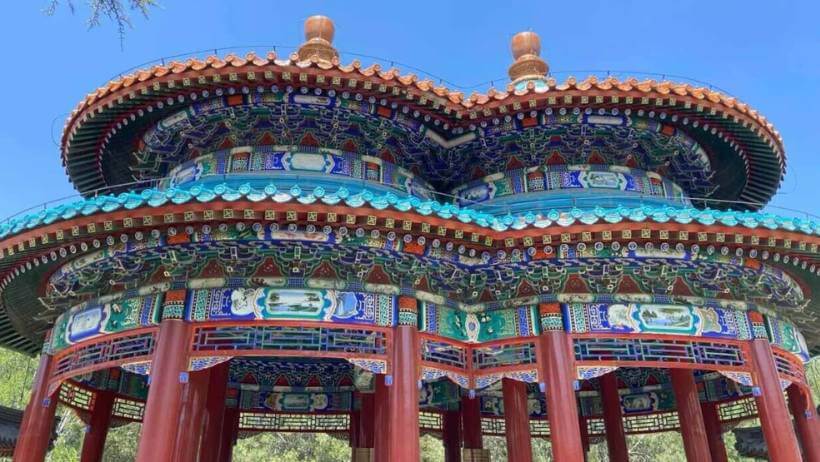
Fact #2: This complex, set in gardens and surrounded by historic pine woods, vividly demonstrates the cosmogony, sacrificial rituals, and scientific and artistic achievements of ancient China.
Temple of Heaven || Hall of Prayer for Good Harvests
Our first stop is the Hall of Prayer for Good Harvests, the most iconic and recognizable structure within the temple complex.
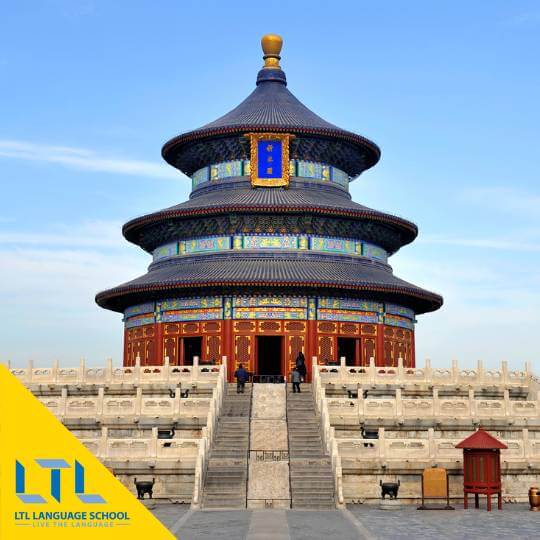
The hall was originally built around 1420 but was reconstructed in 1889 after being destroyed by lightning.
The roof has three layers and is decorated with bright blue tiles and golden ornaments. It reaches up high (38 meters), showing off its impressive architecture.
It’s truly an amazing sight!
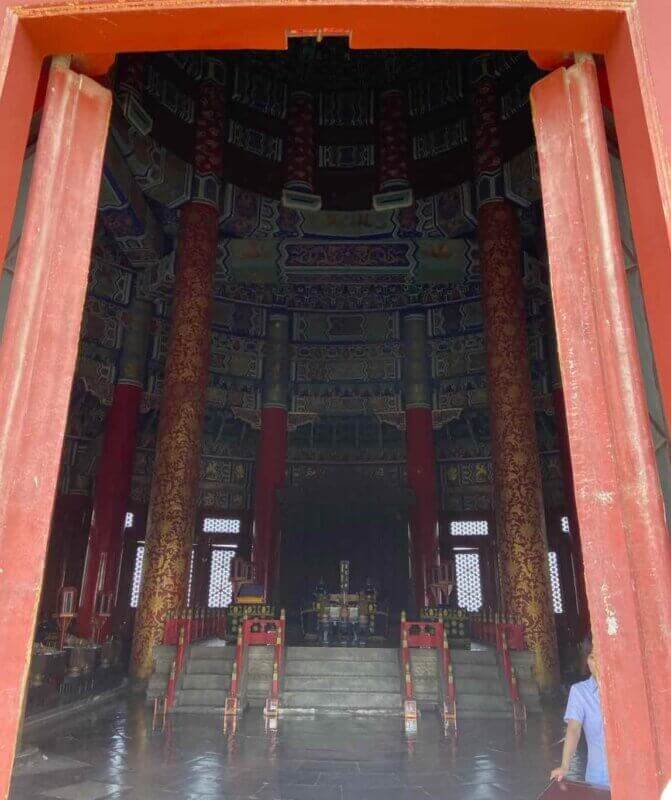
The roof is supported by 28 massive wooden pillars that represent the four seasons, 12 months, and 12 daily hours.
Fact #3: The ceiling features a dragon-phoenix relief, symbolizing the emperor and empress.
Step inside the hall, and you’ll be greeted by the sight of the magnificent wooden pillars, each one carved with auspicious symbols and motifs.
So, make sure to appreciate the Temple of Heaven’s inner beauty too! 😉
Temple of Heaven || Imperial Vault of Heaven
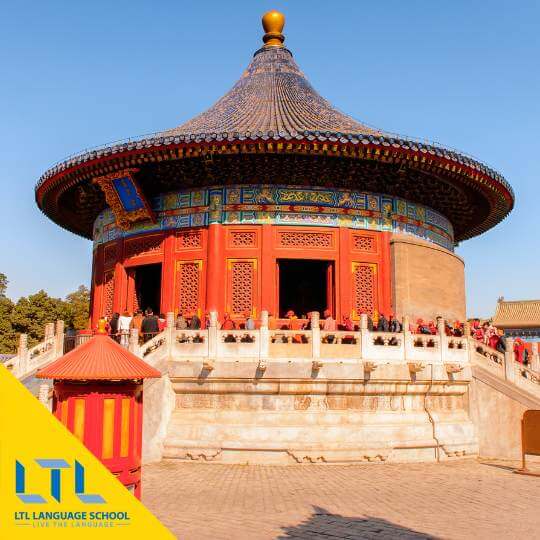
Next, we head to the Imperial Vault of Heaven, a smaller but lovely building tucked away in a peaceful grove of cypress trees.
It is 19 meters tall and 16 meters in diameter, resting on a two-meter-high round marble base.
Here, emperors would store the sacred tablets and ceremonial items used during prayer rituals.
Fact #4: The complex is surrounded by the Echo Wall, which is known for its acoustic properties, allowing whispered conversations to be heard over a distance when spoken close to the wall.
As we stroll around the calm area, pause for a while and feel the peaceful and spiritual atmosphere, like going back to the time of imperial glory!
Where are you planning to visit in Beijing? Let us know in the comments section!
Temple of Heaven || Circular Mound Altar
Our final destination within the Temple of Heaven is the Circular Mound Altar, a circular platform comprised of three tiers of white marble.
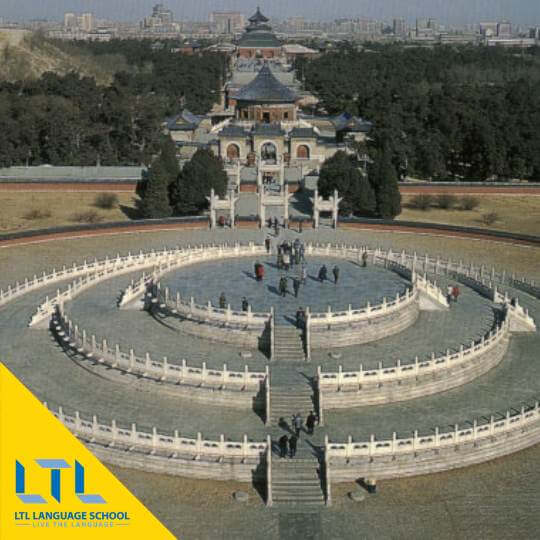
The three layers of the altar are adorned with fan-shaped stones arranged in nine concentric circles.
The number nine represents the ‘Nine-Five Dignity‘ of the emperor (the numbers nine and five, which were considered the highest and most positive numbers in traditional Chinese cosmology, symbolized the emperor’s authority and dignity).
This sacred site served as the main point for the emperor’s rituals, where he would offer prayers and sacrifices to the heavens for a good harvest.
The architectural symmetry and precision of the altar’s design reflect the meticulous attention to detail that defined imperial craftsmanship.

China Travel Tips – 20 China Hacks You Must Know
20 China Travel Hacks to Make Your Time in China Super Smooth Need some China travel tips, tricks, and hacks to help get by in China? If you’re new around here these China hacks are about to become very helpful!…
Temple of Heaven || Spiritual Significance
Beyond its architectural beauty, the Temple of Heaven holds profound spiritual significance for the Chinese people.
It symbolizes the harmonious relationship between heaven and earth, with the emperor serving as the intermediary between the mortal realm and the celestial realm.
The rituals performed here were believed to ensure prosperity, good fortune, and the well-being of the nation.
Want to get off the Beijing tourist track? Check out our list of Top Hidden Gems in Beijing! 💎
Temple of Heaven || Restoration Efforts
The management and maintenance of the Temple of Heaven are carried out strictly in accordance with records in historical documents to preserve the historic condition.
The Temple of Heaven was announced as a “National Key Cultural Relics Protection Unit” by the State Council in 1961.
In 1998, it was recognized as “World Cultural Heritage” by UNESCO.
After the founding of the People’s Republic of China, the state invested a lot of money in the protection and maintenance of the cultural relics of the Temple of Heaven.
Temple of Heaven || Visiting Tips
Before concluding our adventure, here are a few tips to enhance your visit to the Temple of Heaven!

- Be sure to arrive early to avoid the crowds and take advantage of the serene morning atmosphere.
- Tickets are only 28 yuan, but book them in advance (especially during high-peak travel seasons, like summer or national holidays!).
- Consider hiring a knowledgeable guide to provide insights into the temple’s history and significance.
- And don’t forget to bring your camera to capture the breathtaking beauty of this cultural treasure!
Put simply, the Temple of Heaven is a testament to the grandeur of old China, a symbol of ancient imperial power, and a masterpiece of architecture and landscape design.
As you wander through its halls and tranquil gardens, may you find inspiration and enlightenment amidst the beauty of this ancient sanctuary!
Want more from this author? Check out @saratao_chinese on Instagram!
Temple of Heaven || FAQs
What is the Temple of Heaven?
The Temple of Heaven is a sacred space for imperial rituals and ceremonies in Beijing, China.
What emperor commissioned the construction of the Temple of Heaven?
It was Emperor Yongle (永樂) who first commissioned the construction of the Temple of Heaven, which was constructed from 1406 to 1420.
What are the main buildings in the Temple of Heaven?
The complex comprises various structures, including the Hall of Prayer for Good Harvests, the Imperial Vault of Heaven, and the Circular Mound Altar.
What does the Temple of Heaven symbolize?
Some of China’s most famous mountains include Mount Everest, Mount Huang, and Mount Tai. It symbolizes the harmonious relationship between heaven and earth, with the emperor serving as the intermediary between the mortal realm and the celestial realm.
What are some restoration efforts to protect the Temple of Heaven?
The Temple of Heaven was announced as a “National Key Cultural Relics Protection Unit” by the State Council in 1961. In 1998, it was recognized as a “World Cultural Heritage” by UNESCO.
Want more from LTL?
If you wish to hear more from LTL Mandarin School why not join our mailing list?
We give plenty of handy information on learning Chinese, useful apps to learn the language and everything going on at our LTL schools.
Sign up below and become part of our ever-growing community.
BONUS | Learn Chinese with LTL in person. Our student community is growing by the week.


 Hi, my name is Ilaria! I am from Italy and I am a Student Advisor at LTL. Fancy coming to study with us in China? Drop me a message.
Hi, my name is Ilaria! I am from Italy and I am a Student Advisor at LTL. Fancy coming to study with us in China? Drop me a message.




